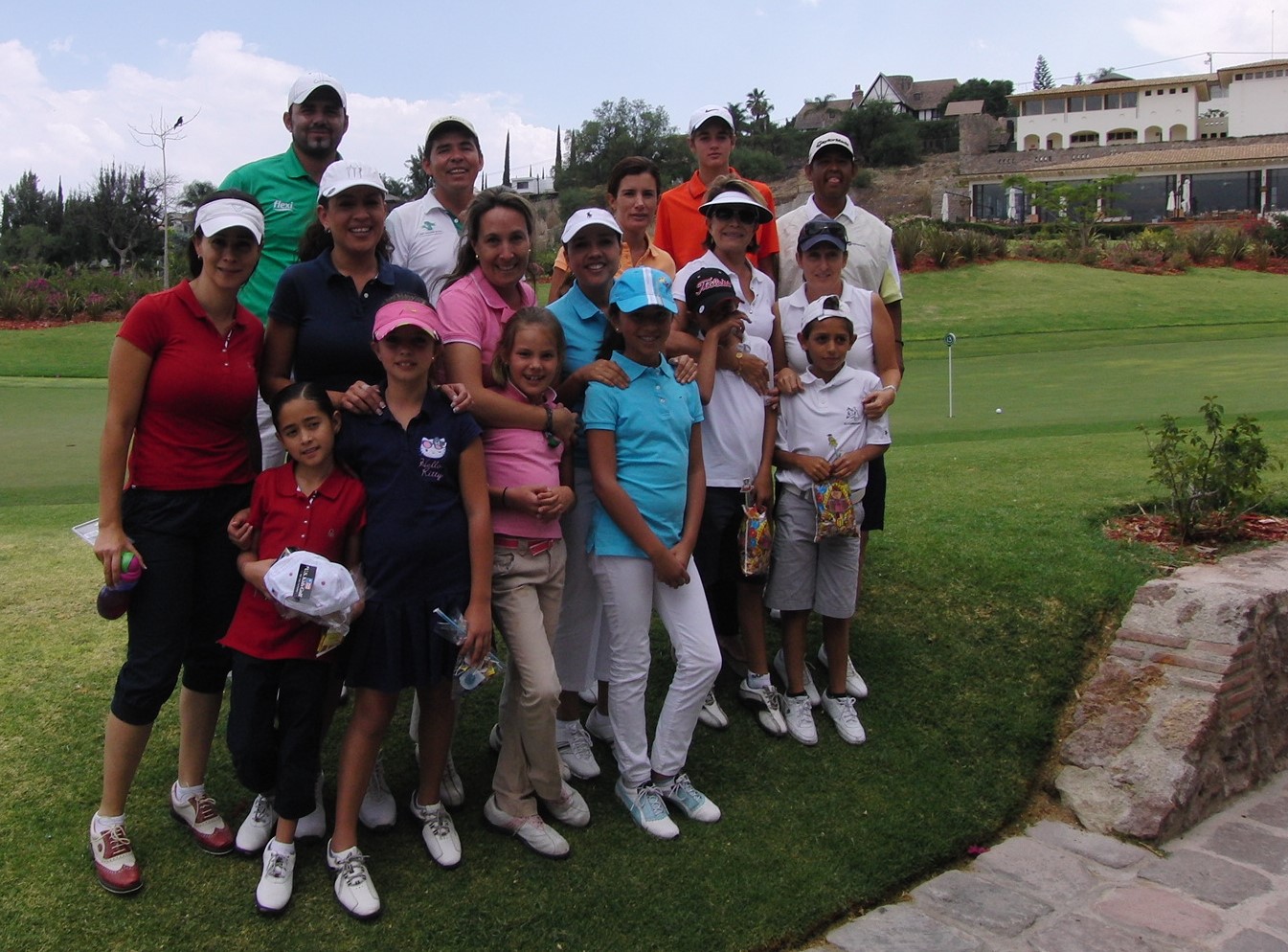
Talking in the 19th Hole
DRIVER. I met Gaby López and María Fassi when they were girls who played the Junior Tour of Mexico’s Valley. It was easy to see her extraordinary abilities. It was a matter of time before they reached collegiate golf in the United States and from there to the LPGA. All Mexicans should be happy that they are in the big leagues, but what about the hundreds of girls and young people who are abandoning golf, some when they are just girls, but others after their youth or university stage?
Some numbers show us that junior women’s golf in Mexico can improve:

We are talking about the metropolitan area of the Valley of Mexico, where more than 20,000 million people live; we only had 13 players in the category 16 – 18. Nuevo León, Tamaulipas, Coahuila, Chihuahua, and Durango only have 12 players. Or that of the Laguna (Torreón, Gómez Palacio, and Lerdo), with more than 1,200,000 inhabitants, we only have one player. This situation is not new, nor is it a product of the COVID 19 pandemic; for years, the numbers were similar.
The problem has many variables. I will share some ideas to help to change this situation that affects us all.
• There is no national strategy. The federation has focused on organizing tournaments for the juniors, the national ranking, and national teams. Still, it has not provided a national system that allows taking a player through the different stages of growth in golf. Each club follows the guidelines that the teachers and executives, in turn, establish. In this link, we can find the way they do it in Canada. In Mexico, a national program is needed to direct efforts at the association and club level.
• The personality. All girls and young people have a personality that makes them different and unique from the rest. For this article’s purposes, we will talk about two personalities: the competitive player and the recreational player. The first focused on competition and the second focused on entertainment.
• Focus on the competition. The clubs, the association, and the federation are focused on training girls to compete. The objective is good; the problem is that there are ages and personalities for it. When a girl faces competition rigors ahead of time, she will most likely feel a heavy load on her shoulders. At first, she will resist out of obedience and education, but she will not endure it for long. With most girls, the focus should be on fun, physical activation, learning, being part of the group, etc. In time they may decide to compete, and they will do well. The fine work is to keep them in golf until they choose to compete. A few girls are competitive from an early age; they enjoy being in competitions.
• We burned the players very early. I was on the practice tee of a particular club when Andrea and her mother came to talk to me. The mother told me, «Professor Andrea has something to tell you.» Andrea said: «I’m not going to play golf anymore. I’m going to go skating.» Andrea was 10 or 11, but she had already competed for five years on tour at that age. She felt that it had been enough golf and had to try different paces. Good for her, but what I think happened is that the emotional burden and pressure of competing at an early age was too much for Andrea, who decided to give up the clubs. It is sad that when girls are entering adolescence, which is the stage where the focus is on training and competing, it is when they withdraw because they went through these stages prematurely.
• Form recreational and competitive groups. To retain more girls in golf, academies can organize groups of recreational players who play golf for education, culture, training, entertainment, etc. Also, groups of competitive players can be organized. This decision should be made by girls and young people, not their parents or teachers. Unfortunately, girls and young women who do not fit into the academies’ competitive scheme are not taken into account, and they abandon golf. Many of these girls have the talent and ability to play good golf, but they are put on the dance floor ahead of time.
• Groups with affinities. Within the same recreational and competitive groups, care must be taken to form groups according to age, personal interests, preferences, etc. Some of the most common mistakes are finding a girl in a group of boys or a girl in a group of girls much older than her.
• The training. It is essential to differentiate training for a competitive player from that for a recreational player. The training will be different in several ways. For example, in terms of time, competitive players can train 2 hours, 4 or 5 days a week. Recreational players can train for an hour, 2 or 3 days a week. If a recreational player receives training for a competitive player, she will end up leaving golf. Competitive training is not for all girls.
• Tournaments. Recreational players can participate in local one-day tournaments, group tournaments, conviviality tournaments, etc. Competitive players can participate from local to international tournaments.
• Distances. I have observed a pattern in girls dropping out. When they play the categories of 9 years and under, playing nine holes, they achieve scores close to par for the course, even less. Parents believe that their girls are almost professional when the reality is that the girls are in what is considered the initiation stage. As the parents see their daughter as a future super player, they begin to give her professional training. When the girl grows to the categories 10-11 and 12-13, where she must play 18 holes at longer distances, it turns out that the score is now 85 as this cannot be possible according to her parents, the days of training, and training increase, be possible with a private teacher. The girl is exposed to excessive pressure and prefers to abort the mission.
It is difficult for the player, the parents, and teachers to accept that if the girl scores 37 strokes in 9 holes, now she makes 43. It would be healthier for girls nine years old and under to play longer distances slightly so that their scores were real according to their play level. So, when they grow up, they can assimilate the fact that breaking 80 is indeed a challenge in golf.
• Recruitment campaigns. The golf academy may run recruitment drives for girls. Personal invitations can be sent to each girl, printed or digital, inviting them to join the golf team.
• Scholarship players from the community. Recruitment can be made to select a certain number of players. The invitation to participate can be extended to daughters of the Club’s employees, to nearby schools and sports clubs. In newsletter six, we talked about this topic.
• Summer courses. In the summer courses, the participants practice different sports and activities. Many participants are external so that the courses can be a source of recruitment. Golf teachers should identify those girls who display golf skills. The golf academy must have a participation scheme for these girls and follow up on it.
• Rescue those who have left. The golf academy can make an effort to rescue girls who have left golf. Many would gladly return, but they don’t because they don’t want to compete, because they don’t like being pressured to play the tour, because they feel sorry to return, because they are not taken into account for not playing the tour, etc. The academy can integrate them into groups of recreational players.
• Give a fun and feminine touch to the golf academy. In clubs, most girls prefer tennis to golf because:
– It’s a more feminine sport.
– They like the style they reflect.
– They have more friends.
– They socialize more.
– They find it more fun.
– They like tennis clothes better.
Copying these details from tennis will help make golf a more attractive sport for girls. For example, the academy can give girls a feminine detail (a cap, a marker, a short-skirt, a shirt, etc.) that identifies them as team members. Making golf lessons fun is a challenge that deserves to be addressed separately.
• Invite the graduates of the academy. One of the best arguments for a girl to be attracted to golf is that she meets local players who have been trained at the academy and who continue to enjoy golf today. It is not about inviting only competitive players who have stood out; perhaps it can be a recreational player who is a mother, who enjoys playing golf with her husband and children. Organizing talks and clinics with these players is an excellent initiative to motivate girls to enter and continue golf.
• Golf teachers. Unquestionably the teaching of golf is dominated by men; perhaps that is one of the main reasons that we have few girls. The federation, associations, and clubs should implement concrete actions to change this situation. Women are easier to teach than men and even more skilled in teaching girls and boys. Many clubs do not have a teacher on their staff. Many parents prefer to entrust their daughters’ instruction to a golf teacher. In my opinion, a teacher can run a golf academy better because she has better communication skills for dealing with parents and for teaching.
• Golfers mothers. Most of the mothers of the boys and girls who participate in golf are not golfers, showing us that dropping out of girls has been around for many years. Mothers should strive to play golf; that way, they could play with their daughters and their families. The girls would be delighted to play with their mom and dad.

Golf clubs sell your membership with the idea that you can play golf with your family. The reality is that very few families play golf together. Most families wouldn’t be able to do it on a Saturday or Sunday morning because club outing schedules don’t include them. The options to play as a family are from Tuesday to Thursday in the long summer afternoons, and the other is to play on Saturday and Sunday afternoons if it can be done at your club.
• The players in limbo. Players (girls) who finish their junior cycle at age 18, often end up in golf limbo. If they study in their city, they do not find someone to play with, as the club tee times schemes have no options for them. There are clubs where a competitive player between the ages of 18 and 25, to say an age, cannot play on a Saturday afternoon or Sunday morning. The groups with tee times are made exclusively for gentlemen, mixed groups, and older ladies. These groups are usually very closed, so they will hardly accept a player with such characteristics.
The same happens to those who studied in the United States. When they return, there is no place for them in the groups on Saturdays and Sundays. And indeed, many executives would tell me «don’t give ideas» if I suggest that there be tee times for the youth players studying in their city or who have already returned.
We must recognize some areas of the country that have identified this area of opportunity and have organized the University Tour. This tour is an excellent option for our players to remain active.
Few girls will make it to LPGA players like Gaby Lopez and María Fassi, but more players are more likely to do so if we attract and retain more girls. If we do, we can get many to play in universities in the United States, and we can get many more to play:
– A weekend with her family.
– On your vacation.
– The parent-child tournament.
– Your club’s annual tournament.
– Interclub tournaments.
– A social tournament.
– A charity tournament.
– A tournament at a convention of your profession.
– And as time goes by, they play with their daughters and granddaughters.
If we manage to retain girls in golf, we all win the players, their parents, the teachers, the executives, the caddies, the club, the community, the golf industry, and the future children of these players. If we don’t, we will all continue to lose. FORE.
